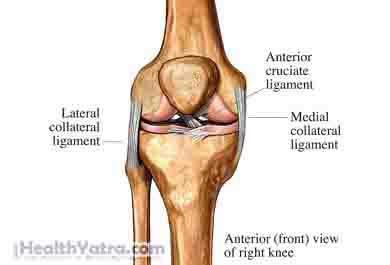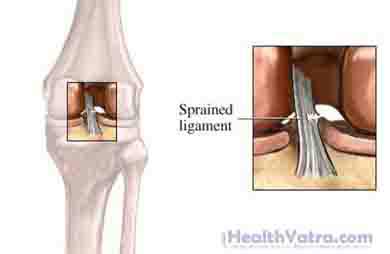परिभाषा
A knee sprain is the stretching or tearing of ligaments that support the knee. Ligaments are strong bands of tissue that connect bones to each other.

का कारण बनता है
Knee sprains may be caused by:
- Forced twisting of the knee
- Stopping suddenly while running
- Shifting your weight while running or skiing
- Landing awkwardly after jumping
- Blow to the outer or inner side of the knee
- Blow to the front of the knee while the knee is bent and the foot is firmly planted on the ground
जोखिम कारक
These factors increase your chance of developing a knee sprain. Tell your doctor if you have any of these risk factors:
- खेल खेलना
- ख़राब समन्वय
- ख़राब संतुलन
- Inadequate flexibility and strength in muscles and ligaments
- ढीले जोड़
लक्षण
लक्षणों में शामिल हैं:
- Pain in the knee
- Swelling, redness, warmth, or bruising around the knee
- Decreased range of motion in the knee
- Inability to stand on the affected leg
- Tenderness where the injured ligament attaches to a bone in the knee
- Swelling within the knee
निदान
Your doctor will ask about your symptoms and how the injury occurred. The knee will be checked to see how stable the joint is and how severe the pain is. Tests may include:
- X-rays—tests that use radiation to take pictures of structures inside the body, especially bone (to assess if any bones are broken)
- MRI scan—a test that uses a magnetic field to make pictures of structures to assess if a ligament has torn completely (less commonly used)
- Arthroscopy—a test that uses a small scope to look inside the knee
Grades
Knee sprains are graded according to their severity. The more ligaments involved the more severe the injury.
- ग्रेड 1
- Stretching and microtearing of ligament tissue
- ग्रेड 2
- लिगामेंट ऊतक का आंशिक रूप से फटना
- Mild instability of the joint when tested
- ग्रेड 3
- स्नायुबंधन ऊतक का गंभीर या पूर्ण रूप से टूटना
- जोड़ की महत्वपूर्ण अस्थिरता

उपचार
उपचार में शामिल हैं:
- Rest—Avoid putting any pressure on your knee by not walking on that leg.
- Ice—Apply ice or a cold pack to the knee for 15-20 minutes, four times a day for two days. This helps reduce pain and swelling. Wrap the ice or cold pack in a towel. Do not apply ice directly to your skin.
- Compression—Wrap your knee in an elastic bandage (such as, Ace bandage). This will limit swelling and provide some support for your knee. Be careful not to wrap the bandage too tightly.
- Elevation—Keep the injured knee raised above the level of your heart. Do this as much as possible for 24 hours or so. This will help drain fluid and reduce swelling. For severe sprains, you may need to do this for a couple of days.
- Oral pain medicine (such as, ibuprofen, naproxen, acetaminophen, aspirin) and topical pain medicines (such as, cream, patches) that are applied to the skin
- Brace—You may need to wear a brace. Your doctor may also recommend that you wear a brace when you return to sports. Although, the American Academy of Pediatrics recommends that children do not use braces.
- Leg cast—If you have a severe sprain, you may need to wear a short leg cast for 2-3 weeks.
- Rehabilitation exercises—Ask your doctor about exercises to restore flexibility, range of motion, and strength.
- Surgery—This may be needed if a ligament is torn completely.
रोकथाम
To reduce your risk of spraining a knee:
- Warm up and stretch before exercise. Cool down and stretch after exercise.
- Take a break from sports and exercise when you feel tired.
- Do exercises that strengthen the leg muscles.
- Learn the proper technique for sports and exercise. This will decrease stress on all your muscles, ligaments, and tendons, including those around your knee. Also, wear the proper equipment.
- Ask your doctor if you should use a brace.
